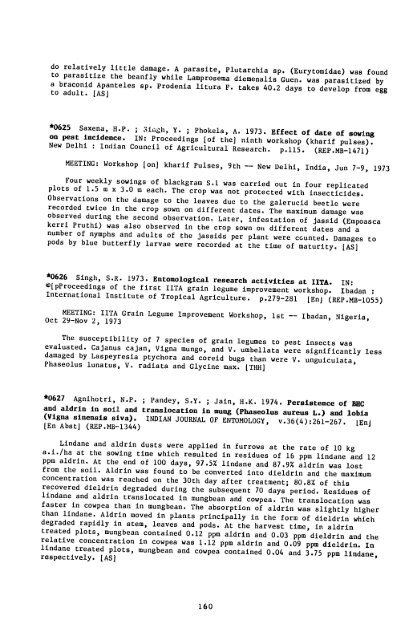PNABD246.pdf
PNABD246.pdf
PNABD246.pdf
You also want an ePaper? Increase the reach of your titles
YUMPU automatically turns print PDFs into web optimized ePapers that Google loves.
do relatively little damage. A parasite, Plutarchia sp. (Eurytomidae) was found<br />
to parasitize the beanfly while Lamprosema diemenalis Guen. was parasitized by<br />
a braconid Apanteles sp. Prodenia litura F. takes 40.2 days to develop from egg<br />
to adult. [AS]<br />
*0625 Saxena, H.P. ; Siagh, Y. ; Phokela, A. 1973. Effect of date of sowing<br />
on pest incidence. IN: Proceedings [of the] ninth workshop (kharif pulses).<br />
New Delhi : Indian Council of Agricultural Research. p.115. (REP.MB-1471)<br />
MEETING: Workshop [on] kharif Pulses, 9th -- New Delhi, India, Jun 7-9,<br />
Four weekly sowings of blackgram S.1 was carried out in four replicated<br />
plots of 1.5 m x 3.0 m each. The crop was not protected with insecticides.<br />
Observations on the damage to the leaves due to the galerucid beetle were<br />
recorded twice in the crop sown on different dates. The maximum damage was<br />
observed during the second observation. Later, infestation of jassid (Empoasca<br />
kerri Pruthi) was also observed in the crop sown ou different dates and a<br />
number of nymphs and adults of the jassids per plant were counted. Damages to<br />
pods by blue butterfly larvae were recorded at the time of maturity. [AS]<br />
*0626 Singh, S.R. 1973. Entomological research activities at IITA. IN:<br />
©[pProceedings of the first IITA grain legume improvement workshop. Ibadan<br />
International Institute of Tropical Agriculture. p.279-281 [En] (REP.MB-1055)<br />
MEETING: IITA Grain Legume Improvement Workshop, ist -- Ibadan, Nigeria,<br />
Oct 29-Nov 2, 1973<br />
The susceptibility of 7 species of grain legumes to pest insects was<br />
evaluated. Cajanus cajan, Vigna mungo, and V. umbellata were significantly less<br />
damaged by Laspeyresia ptychora and coreid bugs than were V. unguiculata,<br />
Phaseolus lunatus, V. radiata and Glycine max. [THH]<br />
*0627 Agnihotri, N.P. ; Pandey, S.Y. ; Jain, H.K. 1974. Persistence of BBC<br />
and aldrin in soil and translocation in mung (Phaseolus aureus L.) and lobla<br />
(Vigna sinensis siva). INDIAN JOURNAL OF ENTOMOLOGY, v.36(4):261-267. [Enj<br />
[En Abst] (REP.MB-1344)<br />
Lindane and aldrin dusts were applied in furrows at the rate of 10 kg<br />
a.i./ha at the sowing time which resulted in residues of 16 ppm lindane and 12<br />
ppm aldrin. At the end of 100 days, 97.5% lindane and 87.9% aldrin was lost<br />
from the soil. Aldrin was found to be converted into dieldrin and the maximum<br />
concentration was reached on the 30th day after treatment; 80.8% of this<br />
recovered dieldrin degraded during the subsequent 70 days period. Residues of<br />
lindane and aldrin translocated in mungbean and cowpea. The translocation was<br />
faster in cowpea than in mungbean. The absorption of aldrin was slightly higher<br />
than lindane. Aldrin moved in plants principally in the form of dieldrin which<br />
degraded rapidly in stem, leaves and pods. At the harvest time, in aldrin<br />
treated plots, mungbean contained 0.12 ppm aldrin and 0.03 ppm dieldrin and the<br />
relative concentration in cowpea was 1.12 ppm aldrin and 0.09 ppm dieldrin. In<br />
lindane treated plots, mungbean and cowpea contained 0.04 and 3.75 ppm lindane,<br />
respectively. [AS]<br />
160<br />
1973

















